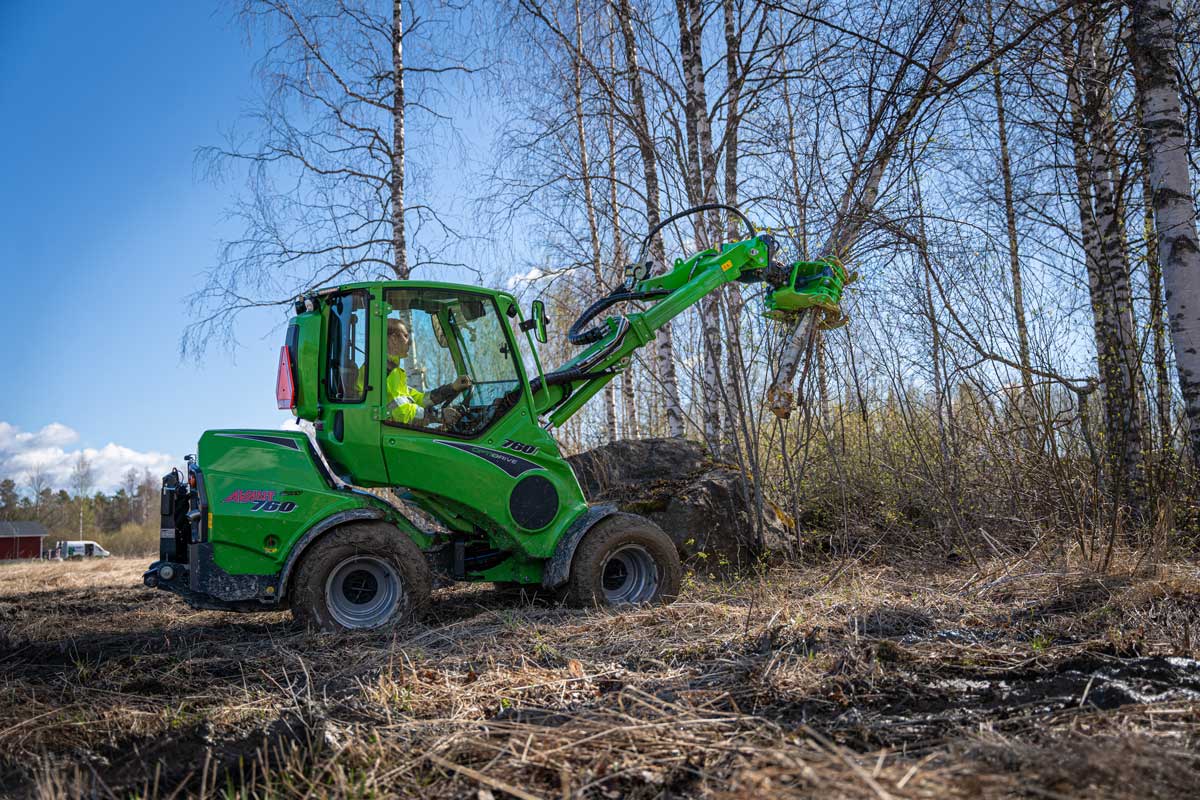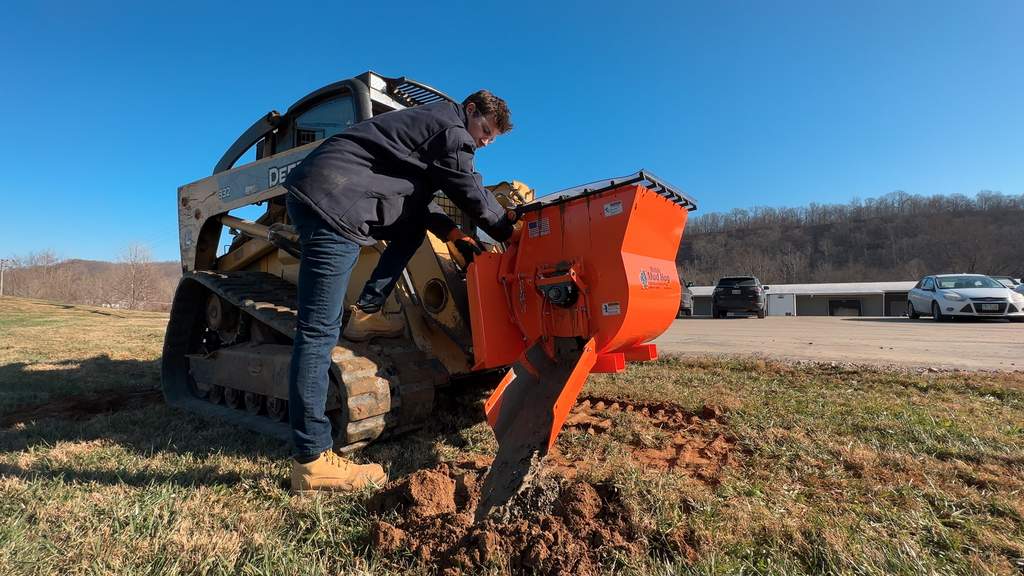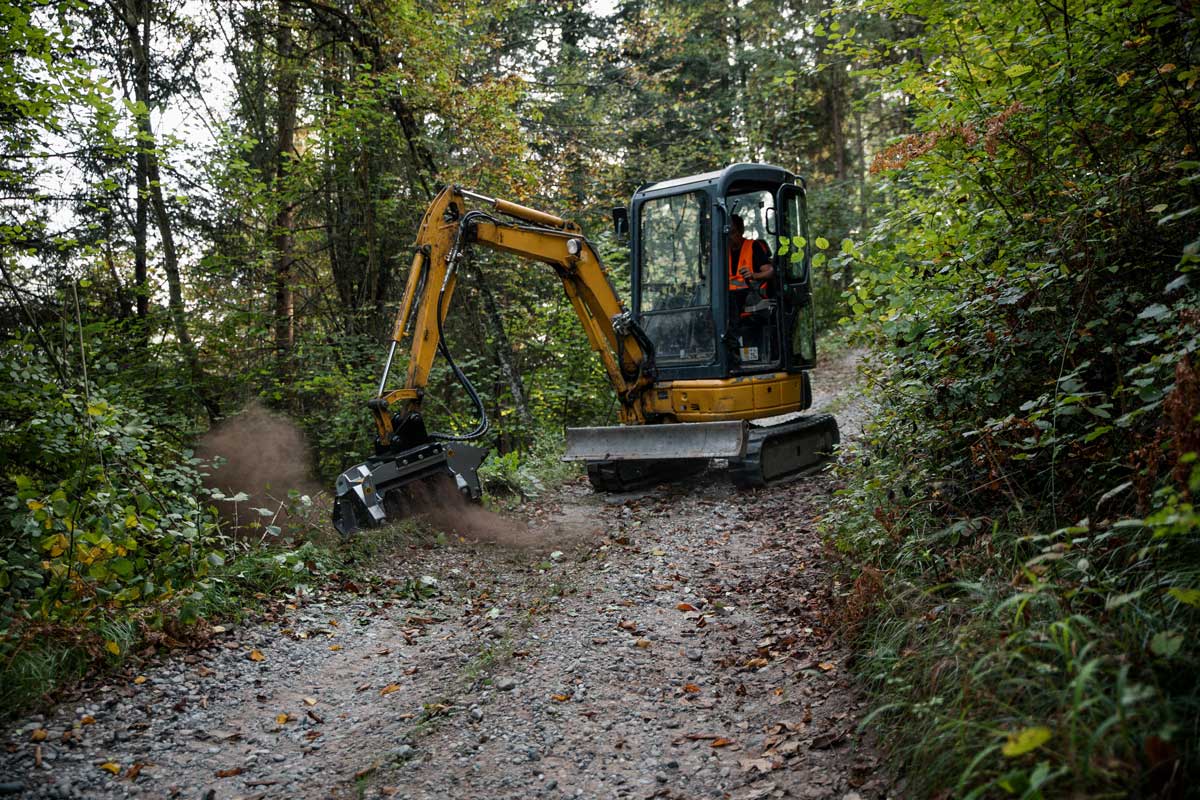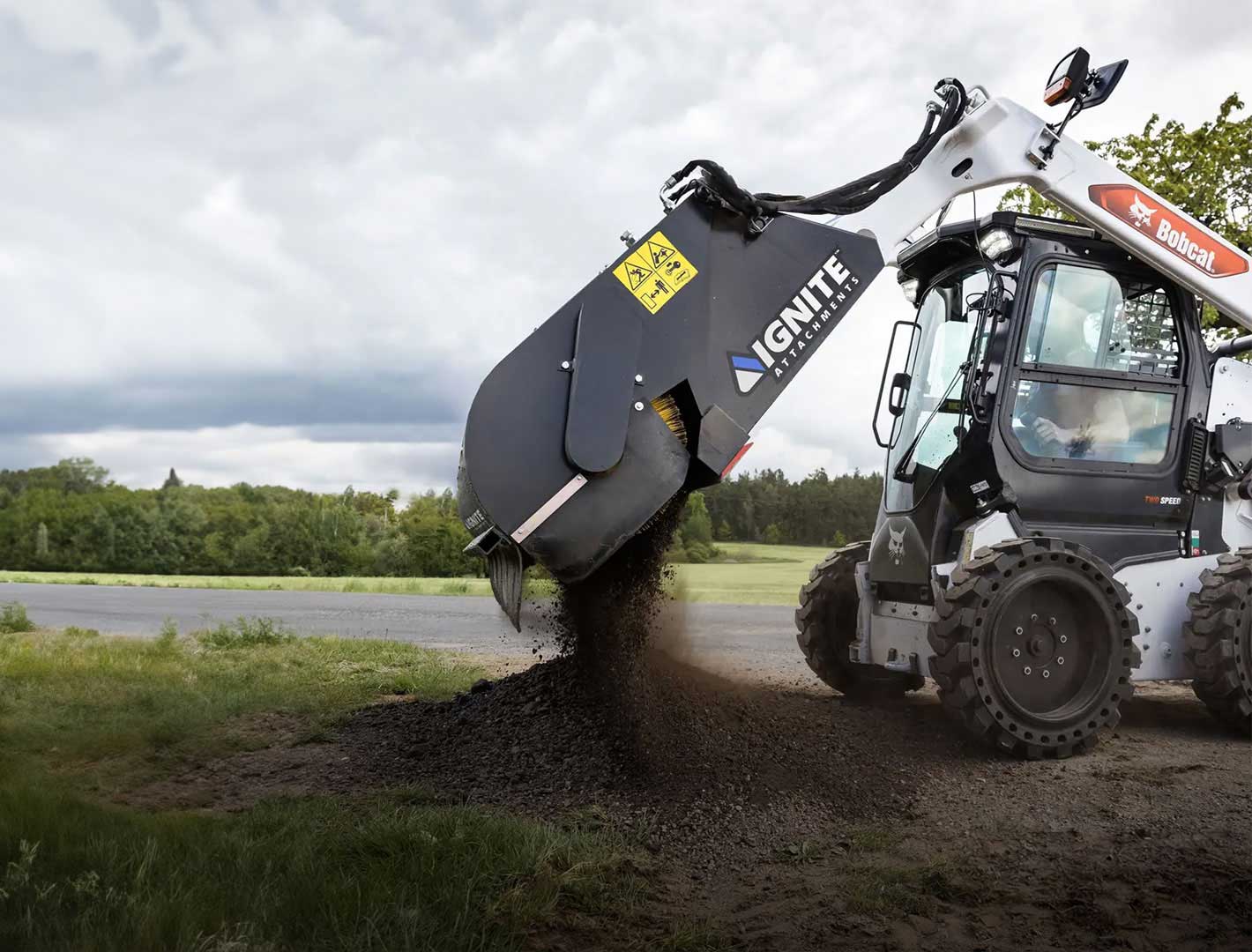Detailing the Variety of Mower, Mulcher and Saw Attachments for Mini Excavators
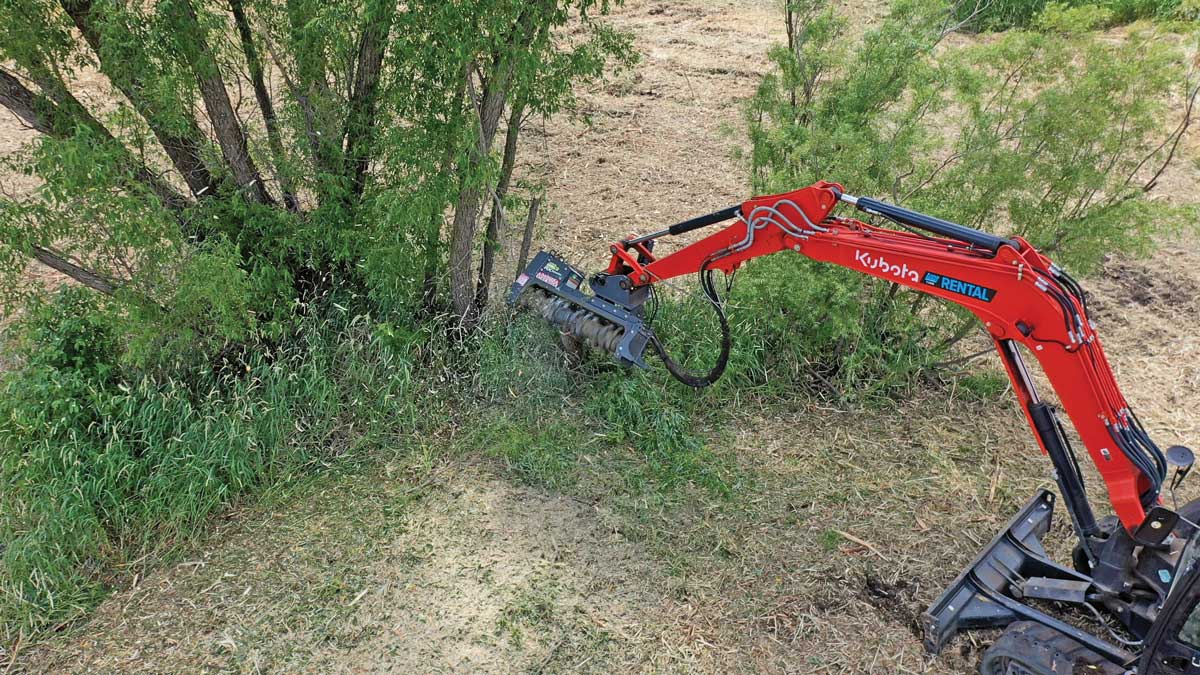
The long arm of a mini excavator gives great reach, allowing everything from digging deep pools to grappling and placing big jersey barriers on road projects. Mini excavators also make great mowing and brush cutting machines with the added ability to extend far and reach high, low and wide to cut awkward brush next to ponds or near roadways. There are a wide variety of mowing and mulching attachments that can be fitted to a mini ex, including rotary-style mowers, drum mulchers, flail mowers and various saws. Each offers distinct advantages and suitability for various tasks, impacting efficiency, cost and the final cut.
“It’s important to consider what materials are going to be cut and what the finished cut will look like,” says Douglas Laufenberg, manager of sales and marketing, compact construction equipment and attachments, at John Deere. “Brush rotary cutters cut down material and leave larger debris, while mulchers can process materials to a finer finish.”
A lot of these attachments look alike, so understand their differences. For a rotary cutter, picture a heavy-duty mower deck with two or three blades spinning beneath that deck, bearing down on saplings and heavy brush and grasses. A flail mower utilizes a shaft with loose, spinning blades (often Y shaped), which are hidden behind a set of protective chains. It’s ideal for reducing heavy grasses, saplings and shrubs into finer mulched material without throwing debris everywhere. A drum mulcher looks similar — it uses a drum and is engineered with lots of removable/interchangeable fixed teeth or knives — but this attachment is used to drop down or up against thicker trees, cut at odd angles and mulch trees and heavy brush into fine clippings. There are also other niche types of excavator mower/mulcher attachment categories on the market, ranging from disc mulchers (which use a giant disc to cut) to tree saws (which can extend into high environments for precise cutting work).
Whether it’s eradication of an invasive plant species or wildfire fuel reduction in drier climates, new uses and opportunities for brush cutter and mower attachments are constantly surfacing. Many factors such as application, terrain, size, weight, horsepower, hydraulics and cost must be considered to make the appropriate selection.
“For maximum performance, it’s important to ensure that the attachment is properly suited for the excavator,” explains Tryg Waterhouse, director of sales for Loftness, which specializes in brush cutting attachments. “That includes making sure the weight and hydraulic capabilities of the excavator can properly handle and power the attachment. Also, make sure you buy or rent from a knowledgeable dealer or rental house. There are many variables that need to be considered when choosing the right machine for the job. Renting is a great way to test the capabilities of a specific machine and make sure it is the right fit.”
Understand Your Host Machine

Before buying or renting a mower or mulcher, determine your compact excavator’s lifting capacity and auxiliary hydraulic capabilities. A mini excavator’s auxiliary hydraulic system specifications — gallons per minute (gpm) and pressure (psi) — will determine the size and power of attachments available. Excavator hydraulic specs range from 5 to 40 gpm and 2,700 to 4,100 psi. Consult your dealer on how to match your host machine’s hydraulic horsepower to the attachment. A rotary-style mower will probably require less hydraulic horsepower than a drum mulcher. Higher flow hydraulic attachments will also generate more heat, so hydraulic oil cooling will be more important for the excavator. Some brands even offer rooftop hydraulic coolers to help.
“Understand the excavator’s hydraulic capabilities and stay within that range,” advises Waterhouse. “As the load increases, the pressure goes up, and the rotor will slow or even stall when the maximum relief pressure is reached. When this happens, performance is decreased, and heat is generated, which could potentially cause damage to the hydraulic system. To reduce the amount of pressure and maximize productivity, operators should refrain from engaging material too quickly.”
Understand the rated lifting capacity and reach of the host excavator. Focusing on lighter weight brush cutters and mowers will be important to ensure maneuverability, safety and fuel economy. Another factor that makes excavator attachment selection different than with skid steers and track loaders is the lack of a universal mounting system. That means the end-user needs to work with the equipment dealer to ensure the appropriate mounting style is installed for the type of excavator being used.
“Mounting styles for excavators include pin-on mounts and pin grabber mounts,” says Waterhouse. “There are also options like spade hooks and hydraulic thumbs, which are useful for positioning material when mulching. Another highly recommended option for an attachment like the Battle Ax is a tilt hitch. A tilt hitch allows the operator to hydraulically tilt the attachment to the left or right. This can really increase productivity through better positioning of the attachment for the job at hand.”

Of course, before operating, the compact excavator itself should have a comprehensive protection kit (brush cutting requires serious safety precautions). Here’s a common checklist of safety equipment: an exhaust cover to prevent debris entering the engine bay; cab-glass reinforcement; front work light protection; hydraulic hose and auxiliary coupler guards; FOPS guard with side protection; and even a cooling pack guard.
“Always protect the operator with a minimum of a half-inch thick polycarbonate shield,” says Matt Nelson, director of development at Diamond Mowers, which offers a wide range of brush cutting attachments for various tool carriers. “Also, be mindful of thrown debris. All this equipment can throw both sticks and rocks, so keep the surroundings top of mind.”
TrackGrip Track Attachments
Discovery Channel’s “Hoffman Family Gold” Crew Are the New North American Ambassadors
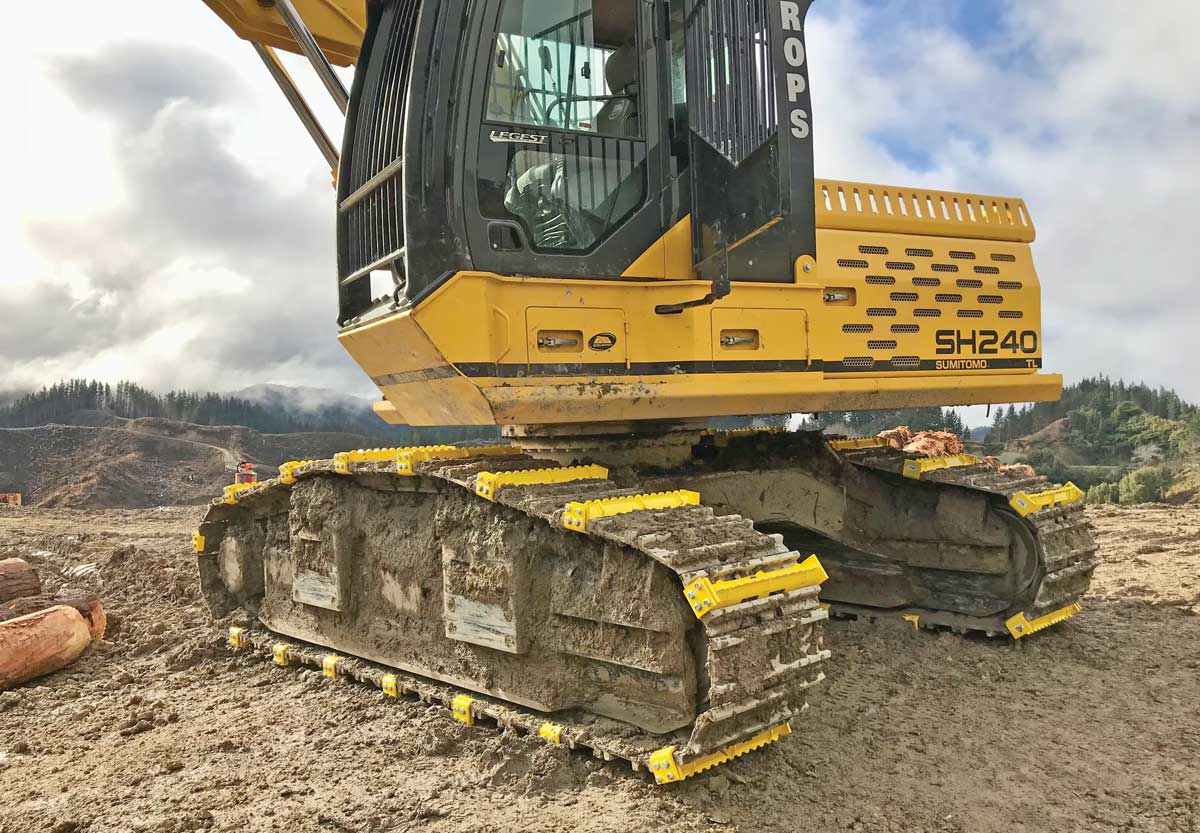
Mud, rock, ice, permafrost or mountainous forests, the toughest terrain and harshest conditions are no match for TrackGrip attachments. So, it’s fitting that the brand has secured Todd Hoffman, reality star and creator of Discovery Channel’s “Hoffman Family Gold,” as brand ambassador, along with his father Jack Hoffman and foreman Andy Spinks. As miners, Todd Hoffman and his crew use TrackGrip’s range of durable and patented excavator and tracked vehicle attachments to increase traction in some of the most intense terrain in the world, from icy slopes to dense mud, helping get the job done safely and effectively. Of course, these TrackGrip attachments work great on compact excavators and compact track loaders as well. TrackGrip already has over 400 dealer locations across North America, including Finning Cat, and the Hoffman collaboration will shape the future of the business both in the USA and internationally. For more info, visit trackgrip.com.
Rotary-Style Mowers and Mulchers
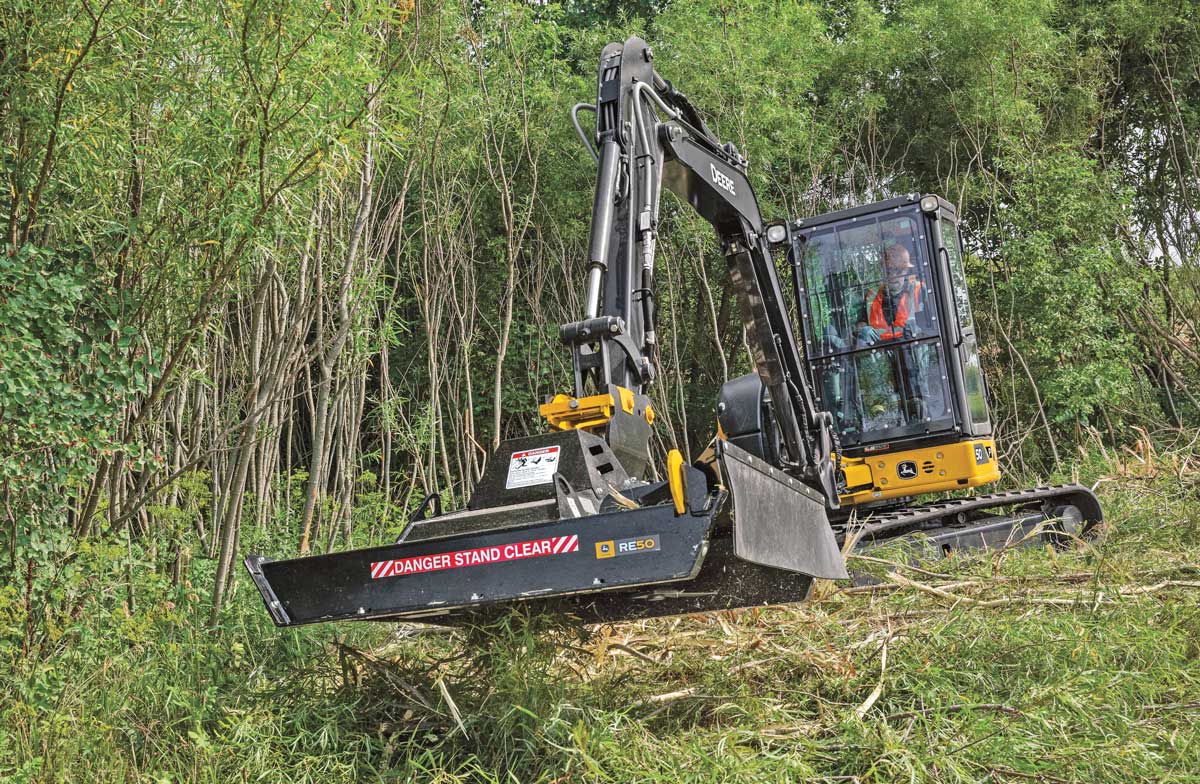
Rotary-style mowers are favored for their speed, versatility and low cost. As the excavator arms swings, the rotary mower swiftly chops down brush and grass. There are two major types on the market: rotary mowers (which use a deck with protective sides made of metal, rubber flaps or chains to keep debris from flying) and rotary clearing mowers (which keep the front or sides of the deck open to clear and spit out debris quickly.
“In general, [rotary-style] brush cutters are perfect for dealing with tall grass, small trees, large-scale brush clearing and maintaining fence lines,” explains Nelson at Diamond Mowers, which offers its EX Drum Mulcher DC Pro X, which is a rotary-style clearing mower. “These heads are popular with contractors, farmers, ranchers, municipalities and landscaping companies.”
Rotary mowers and mulchers are particularly effective in areas where rapid clearing is more critical than the fineness of the mulch produced. Rotary mowers do not have sharp blades. Instead, typical rotary mower attachments for heavy-duty use feature blades that are large and thick for clearing overgrown brush. Because these blades are rough, they are designed more for power than for a clean cut.
“In general, a flail mower will deliver a smoother cut in grass than a brush cutter and will contain thrown debris somewhat better,” says Nelson. “Our [rotary-style] brush cutters will work though material that is too large for a flail and do it a lot quicker. They’re best used in more rural applications.”
A rotary-style mulcher can clear dense brush and saplings usually up to 2 or 10 in. in diameter via two or three spinning steel blades. Cutting widths on compact excavators usually range from around 36 to 72 in. Technologies like stump jumpers, cushion/relief valves, case drains and blade shut-off protection systems are often engineered into brush cutters to protect the engine, gearbox and workers.
“Our RE40 and RE50 [rotary-style] brush cutters feature three swinging blades mounted to a blade carrier and can fell and cut material up to 6 in. in diameter,” says Laufenberg. “A heavy-duty hinged debris shield retracts when the head is engaged with trees and brush, exposing the blades and allowing for aggressive cuts. Also, the RE40 and RE50 brush cutters’ directionally beveled blades push material into the head of the cutter, creating fine debris for recycling. The blades are also reversible, so when the leading-edge wears, they can be unbolted and flipped over for a fresh cutting edge.”
Other considerations include direct drive versus motor gearbox combinations, three blades versus two blades, bidirectional operation and length of warranties (usually one to three years). Cost is also a considerable factor. Typically, rotary mowers and mulchers are less expensive than drum mulchers and flail mowers, both in initial investment and maintenance.
Drum Mulchers
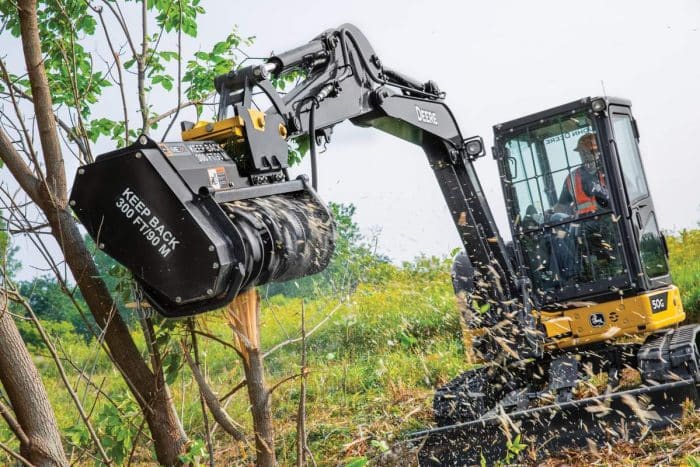
Drum mulchers offer a different approach. They use a cylindrical drum lined with fixed teeth to grind down vegetation. This method produces much finer mulch, which is a significant advantage for projects requiring soil enrichment and protective ground cover. Drum mulchers come in a variety of widths for compact excavators from 28 to 50 in., boasting the ability to cut thick brush and trees up to 10 in. thick.
“An attachment like the Loftness Battle Ax is more versatile than one with spinning blades,” says Waterhouse. “That’s because it can mulch larger diameter trees, as well as mow tall grass and brush. It doesn’t just cut the vegetation down. It mulches into small pieces, which is typically a more desirable ground finish. It’s a great option for someone looking to perform all of these jobs. However, if the attachment will only be used for grass and smaller brush, and a mulched finish is not desired, then a less-expensive brush cutter may be a better fit.”
While rotary-style brush cutters are used more for heavy brush and mass acreage, drum mulchers mowers are more geared toward thicker trees, stump removal, elevated shrubbery (around power lines or near buildings) along with just general brush cutting. Drum mulchers produce a finer, more consistent mulch that can help in soil stabilization and moisture retention. Though slower, drum mulchers are more thorough, using a variety of teeth options to tackle specific brush. These teeth are fixed to the drum and don’t swing like a flail mower.
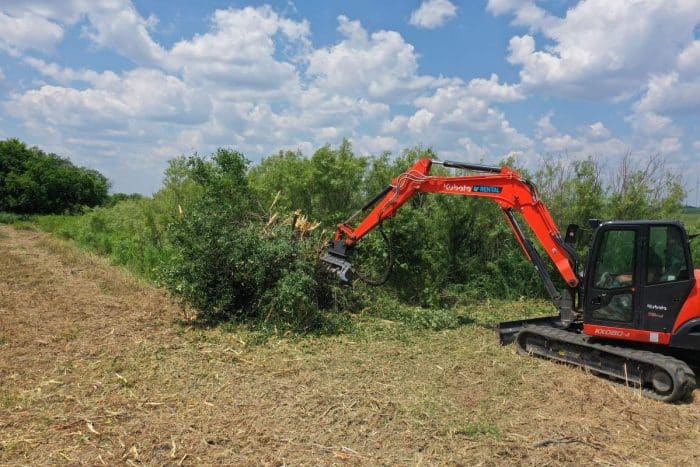
“Attachments like the Battle Ax have multiple tooth options,” says Waterhouse. “Sharpened knives are the most aggressive and higher performing option, but they require regular sharpening. Four-point beaver teeth offer less slicing performance than knives, but they have four points to help pick up material from the ground. The last option is carbide teeth, which are the least aggressive but most durable option. Carbide teeth are most ideal when operating close to the ground in rocky terrain. Being able to work with all teeth options is where the Battle Ax rotor design excels. Many competitive attachments suffer productivity loss when using less-aggressive teeth.”
One of the more noticeable differences in drum mulchers today is the rotor style. There are open drum mulchers without limiters or depth gauges, which are the best choice for applications where significant ground contact is expected or when mixing mulch into the soil. Then there are mulching heads with some sort of depth control system or limiter to prevent the attachment from biting into material too aggressively, which can slow the rotor and lower performance. These limiters are designed to allow the optimal amount of material into the drum to achieve the highest possible production rates. This feature is especially advantageous for increasing efficiency with compact excavator heads, since excavators typically don’t have abundant hydraulic horsepower to put toward the attachment as many skid steers do.
The two main types of limiting rotors available today are ring-style and depth gauges. To learn more about these styles and lots of other info about drum mulchers (like two-stage cutting units), click on this in-depth story penned by the experts at Loftness.
Flail Mowers, Disc Mulchers and More

A flail mower looks kind of like a drum mulcher, but it features a rotating shaft with multiple flails or blades attached, designed to swing freely at their pivots. The individual knives within a flail mower attachment are typically Y- or T-shaped blades that spin around the shaft. Y-blades (which look like a Y) are great for cutting tall weeds and overgrowth. Hammer blades (which look like a T) are used to mulch trees and destroy serious foliage. When mounted on a compact excavator, the flail mower becomes a powerful tool that can clear thick brush, grass and small trees with ease, giving a more finished look. Unlike traditional mowers, the flail mower’s design minimizes the risk of flying debris, making it safer and more suitable for populated or sensitive areas.
Disc mulchers or forestry discs are large, circular spinning cutter heads with cutting teeth looping around the disc head. Mulching discs are ideal for large areas, and they can process both large and small diameter materials. These are often called forestry mulchers because they are used on bigger excavators for reclaiming and deforestation, particularly in steep areas like riverbanks, around power lines and pipelines and next to railroad tracks. Disc mulchers are ideal when speed and efficiency are major factors, matched with a rural or wooded setting that doesn’t have people or buildings.
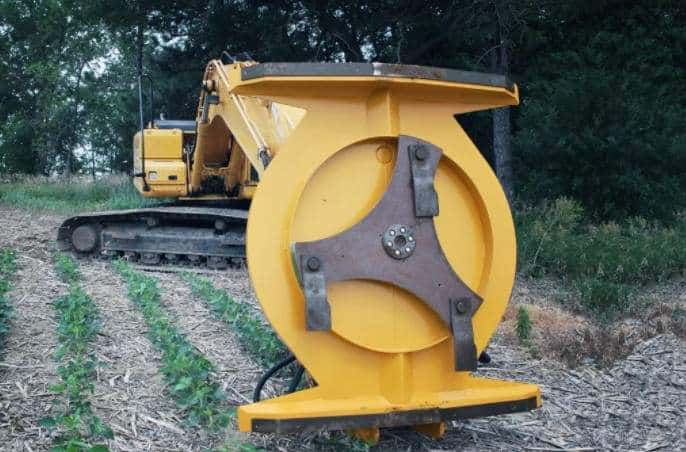
There are also a variety of tree saw attachments for excavators on the market. Many of these tree saws incorporate high-speed circular blades with replaceable teeth that can be titled 180 degrees for precision cutting work like trimming and limbing trees. Some of these tree saws even come with extending booms that reach heights up to 25+ ft. We’ve even seen grapple saws that combine a log grapple with a tree saw, allowing excavators to both cut and grab a tree at the same time.
It’s safe to say there are lots of options when it comes to compact excavators and mowing and mulching attachments. With the right hydraulic cutter, compact excavators can make for fairly gnarly and extremely effective saws, cutters, mulchers and mowers in a variety of vegetation removal projects, cutting over rails on roadsides, navigating near waterways and lakes, adding flotation and reach in forest cuttings and capitalizing on nimble mowing maneuverability in high reach jobs and congested work areas. There’s always more to know, so explore “brush cutters” on this website to learn more about these mowers and cutters.
Keith Gribbins is the publisher of Compact Equipment.
Three Reasons to Rent Mini Excavators
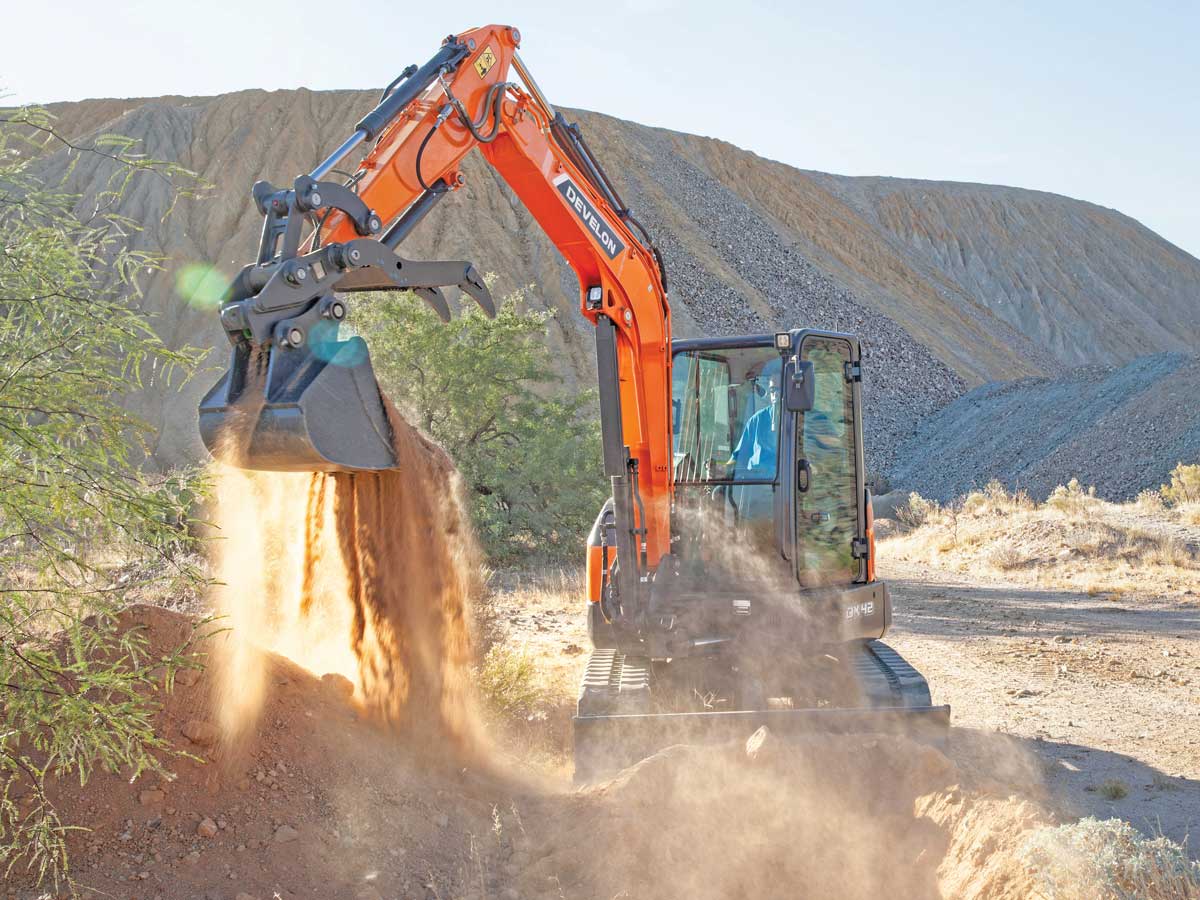
If you’re unsure whether renting a mini excavator is right for you, we have some helpful advice. Here are three reasons why renting can be advantageous over buying a mini excavator.
Workload Capacity
If you don’t regularly require a mini excavator for your work, or if your anticipated need is minimal, renting is a smart choice. Renting a mini excavator for a project or two will afford you the opportunity to try it out. You may determine that it isn’t necessary to include one in your equipment lineup, because when you do need one, it’s easy enough to visit a local dealership or rental company in your area for short-term needs. Additionally, if your mini excavator requirements vary in terms of machine size and dig depth, renting provides the flexibility to choose the best machine for your immediate needs.
Cost-Effectiveness
Renting a mini excavator can be more cost-effective than purchasing one. When you buy equipment like a mini excavator, you may incur additional expenses for things like maintenance and repairs, insurance, transportation and depreciation. Renting alleviates these worries about extra costs and allows you to focus on your project. Avoid the long-term financial commitments associated with ownership by renting until you’re ready to buy.
Access to New Models and Technology
Another reason to consider renting a mini excavator instead of buying one is to gain access to the latest technology and newest models. Dealers and rental companies routinely update their equipment fleets, meaning you benefit from upgrades like enclosed cabs with heating and air conditioning, Bluetooth technology, rearview cameras and telematics for remotely monitoring the machine. In addition to renting mini excavators, you can rent attachments for specific projects (for example, a hydraulic breaker for a demolition project). A rental company can help you determine the best size of machine and the features you need; then supplement it with attachments for optimal performance.

